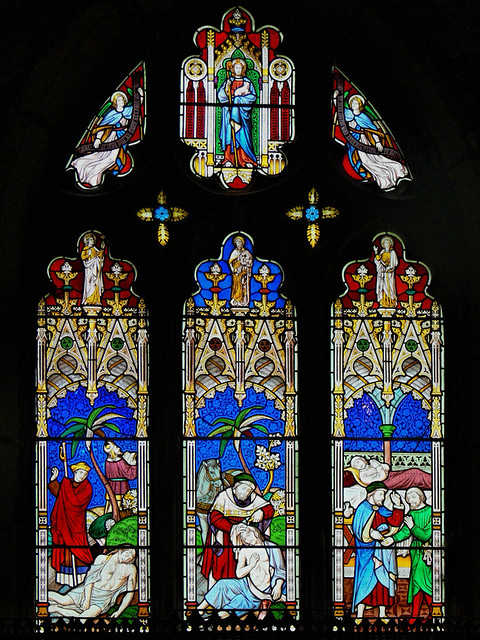Good Samaritan - Market Bosworth Leicestershire

This vibrant Victorian stained glass window, created by the prolific English glass painter William Wailes (1808–1881) around 1850–1860,1 is located in the east window of the south aisle at St. Peter and St. Mary's Church in Market Bosworth, Leicestershire, England. Wailes, founder of one of Britain's largest stained glass studios in Newcastle upon Tyne, was renowned for his High Victorian Gothic Revival style, blending medieval-inspired tracery with narrative clarity and jewel-toned colors achieved through pot-metal glass techniques. Commissioned during the Gothic Revival's peak, the window illustrates the Parable of the Good Samaritan (Luke 10:25–37), emphasizing Christian charity and compassion, themes resonant in 19th-century Anglican moralism.
In the trefoil apex, the Good Shepherd serves as a typological crown, linking Christ’s pastoral care to the Samaritan’s mercy. Christ, depicted as a youthful shepherd in a flowing red tunic and blue mantle, stands centrally holding a lamb tenderly in his arms, its white fleece contrasting his golden halo. His serene face, framed by curly hair, gazes downward with compassion, symbolizing protection and sacrifice (John 10:11). Flanking angels in white and rose robes, their wings edged in gold, hover with harps or censers, enhancing the celestial mood. This imagery, rooted in early Christian art, reinforces the theme of salvation, paralleling the Samaritan’s act with Christ’s ultimate redemption.
The main three lancets narrate the parable sequentially, left to right, with biblical landscapes of palm trees and rocky outcrops. A red-robed traveler is attacked by two brigands, one with a club, the other stripping his cloak, as he falls wounded. A priest in gold and blue vestments passes by, eyes averted, symbolizing ritual without compassion. A base angel gestures upward, urging moral reflection, amid blues and greens. A Levite in green and white turns away from the victim, while the Good Samaritan, in brown and turbaned attire, arrives on a donkey (implied by reins). He binds wounds, anoints with oil from a horn, and pours wine from a jug, his face alight with empathy. A base angel with a shield reinforces protection, framed by a blue palm and gold highlights.The Samaritan leads the donkey to an inn, paying the innkeeper with coins and ensuring the victim’s care. Helpers and a child add warmth, with a base angel holding a lily. Reds and yellows culminate the narrative’s call to charity.
The Good Shepherd upper register, a Victorian reinterpretation of early Christian iconography, aligns with the era’s moral and theological focus, complementing the Samaritan’s earthly kindness with Christ’s divine model.
